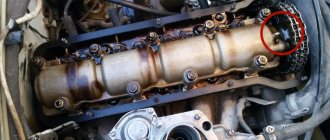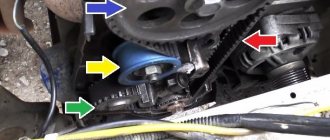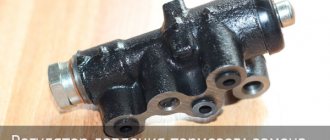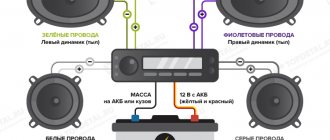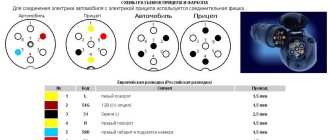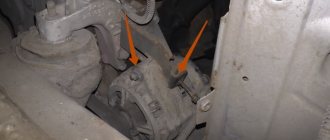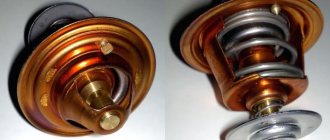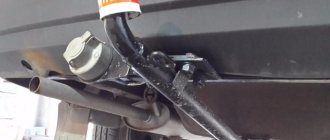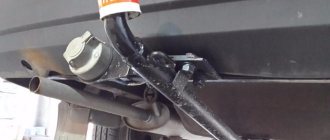Installation of camshaft VAZ 2107
The cylinder head camshaft is installed in the reverse order of removal. Before installing the part into the housing, it is necessary to lubricate the support journals with engine oil. When assembling, you should pay attention to two important points:
- correspondence of the marks on the camshaft and on the sprockets of its drive;
- tightening torque of the camshaft housing nuts.
First, you need to properly tighten the camshaft nuts. The nominal tightening torque of the nuts is 2.2 kgf•m. You cannot immediately tighten the fastening to such a torque. The VAZ 2107 camshaft is tightened in three to four stages so that the body is pressed evenly, without distortions. The nuts should be tightened from the center to the edges, in accordance with the “tightening chart” (see figure).
When the camshaft is installed, it is necessary to set its position relative to the crankshaft. There are marks on the camshaft bed, the front engine cover and the crankshaft and camshaft sprockets that should be followed. Even if the drive chain has been securely attached to the sprocket, when installing the camshaft, make sure that its position matches the position of the engine crankshaft. To correctly set the marks on the VAZ 2107 camshaft, you must perform the following steps:
- make sure that the mark on the crankshaft pulley is located opposite the long mark on the front engine cover (this corresponds to the top dead center of the fourth cylinder);
- install the sprocket on the camshaft and make sure that the mark on it matches the mark on the “bed”;
- put the chain on the sprockets without disturbing the position of the shafts;
- make sure that when the chain is tensioned, the marks match;
- tighten the camshaft sprocket bolt;
- turn the crankshaft two turns with the wrench;
- check the alignment of the marks on the camshaft and crankshaft;
- if necessary, change the position of the chain on the camshaft sprocket;
- Tighten the camshaft sprocket bolt and secure the lock washer.
After this, all that remains is to adjust the chain tension using the tensioner and complete the assembly by installing the cylinder head cover and other parts.
The camshaft (camshaft) is one of the most important elements of the gas distribution mechanism (GRM). The camshaft's job is to ensure timely intake of clean air and exhaust of exhaust gases from the combustion chamber by opening and closing the intake and exhaust valves.
The camshaft is located in the upper part of the cylinder head (cylinder head), the crankshaft is connected to a pulley and a toothed sprocket using a timing chain or belt.
The main malfunctions that require repair or replacement of the camshaft include increased wear, scratches and risks on the camshaft bearing journals, numerous scuffs or camshaft deflection (deformation).
Loss of pressure in the engine lubrication system. As a rule, the cause of this is severe wear of the camshaft journals, as well as in the event of a violation of the camshaft bearing seats in the cylinder head. The second case requires a complete replacement of the cylinder head, due to the fact that the sockets are located in the cylinder head body itself.
Strong knocking of valves in the presence of working hydraulic compensators, increasing gaps in the valve drive mechanism. The reason is increased wear on the camshaft cams, the use of low-quality engine oil, and a non-working or clogged oil filter. These malfunctions are also characterized by loss of power and interruptions in engine operation.
Also, the camshaft is replaced in the case of engine tuning, when the standard camshaft is replaced with a sports one with radically different characteristics, intake/exhaust phases and slightly modified cams. This is necessary to increase power or improve the efficiency (efficiency) of the motor.
Today I will talk about how to replace the camshaft of a VAZ 2107, VAZ 2106 with your own hands, using improvised tools in a garage.
Self-tightening of VAZ 2108 cylinder head bolts instructions, photos and videos
In order for a car to always work correctly, all its components must function properly. This is especially true for the power unit. If you want to know how the VAZ 2108 cylinder head bolts are tightened, why is this necessary and what is needed for this? Our resource will help you understand these issues.
In what cases is tightening needed?
Most domestic drivers do not understand for what purpose this procedure needs to be performed, what order must be followed and what the tightening torque should be. However, every driver should know that incorrect actions during this process can damage the cylinder block. Accordingly, this procedure should be treated with all care and responsibility.
Just a few years ago, vehicle manufacturers were required to tighten the cylinder head bolts during the first maintenance of the vehicle. But now this need has disappeared and now it falls entirely on the shoulders of the drivers. If you are the owner of a VAZ 2108, then this procedure should be carried out from time to time. In what cases is it needed:
- If an oil stain appears in the place where the cylinder head connects to the block itself. This indicates a leakage of consumable fluid, which can be a consequence of both wear of the gasket itself and loosening of the pins.
- If you have done engine repairs. Sometimes even qualified specialists can make such mistakes. Therefore, the owner of a VAZ 2108 may find this information useful.
- For verification purposes. Experienced car enthusiasts recommend tightening the bolts at least every 2 thousand kilometers. In practice, there are cases when during the operation of the VAZ 2108 the pins loosen on their own.
Thus, if you notice a leak of engine fluid in the place where the head connects to the cylinder block, first of all you need to check the tightening torque of the pins.
Procedure and diagram
We advise you to tighten the torque of the screws if you have ever encountered such a process. The following will describe the general procedure for the Lada 2108, but it should be noted that each engine has its own operating nuances that need to be taken into account.
Necessary tools
You will need a torque wrench for this procedure. This tool is needed specifically for tightening screws and determining torque. It can be purchased at any specialized store, and its price fluctuates around 1,300 rubles (approximately 400 hryvnia).
Sometimes so-called “masters” say that it is not necessary to use a torque wrench for this procedure. They say that an ordinary wrench will work just fine, and in general, you can tighten the screws “by eye.” Naturally, it will be possible to tighten the screws, but it will be incorrect, and later this may cause other problems.
Stages
If you feel that the quality of the head screw is poor, then do not even try to tighten it. Replace it immediately to protect yourself from possible problems. In addition, before the actual procedure, you should check the quality of the thread. It is also advisable to lubricate it. Do not forget that reusing spring parts is unacceptable, since in this case you will not achieve normal tension.
The stages of tensioning the pins on the Lada 2108 are similar to those performed on classic car models. The diagram is provided below. The process itself should begin with the central bolts. It takes place in four steps.
- Using the above tool, all cylinder head bolts must first be tightened to a torque of 2.0 kgf*m. First, the two middle elements are tensioned, then the two lower and two upper ones, which are located on the sides of the middle bolts. Then you need to tighten the two leftmost and two rightmost screws, starting with the bottom ones. The order should be exactly like this. The numbers on the diagram indicate the order of the components.
- Then, in the same order, using the same tool, you need to tighten the components with a torque of 7.5 - 8.5 kgf*m.
- After this, all pins must be tightened 90 degrees.
- Then they should be turned again, again by 90 degrees.
Timing phases and when to set them according to marks
Valve timing refers to those moments at which the piston in the engine moves up and down over a certain interval. When irregularities in the valve timing occur, the pistons move incorrectly along the interval, resulting in uneven engine operation on the VAZ-2107.
If the driver notices that the car’s power decreases, fuel consumption increases, and engine interruptions occur, then it is necessary to resort to setting the valve timing according to marks. How to set marks on a VAZ 2107 carburetor and injector, we will learn from this material, since the design of the timing mechanism is identical.
How to set timing timing marks
The procedure involves performing the following manipulations:
- The VAZ 2107 needs to be placed on a hard surface, with chocks placed under the wheels and the hand brake pressed all the way. The gear shift lever must be set to neutral mode.
- The cover is removed from the cylinder head by first unscrewing all the fixing nuts to “10”. It is better to replace the gasket with a new one, even if the old one shows no signs of damage.
- Using a key set to “24”, you need to turn the crankshaft on a VAZ 2107 car. This is done in order to be able to align the marks on the moving and stationary parts of the mechanism. To carry out these actions, it is recommended to use good lighting or use a flashlight. The crankshaft rotates until the mark on the pump and generator drive belt pulley coincides with the long mark marked on the block.
- Combining these risks, the mark on the sprocket should eventually coincide with the ebb on the camshaft bed. If the mark ends up at the bottom, then you should rotate the crankshaft 360 degrees.
- If you can’t make sure the labels match, then proceed to the next steps, which are described below.
- The crankshaft is rotated until the marks on the star and the bed ebb align.
- Using the key at “13”, you need to loosen the tensioner. The 2 nuts securing the tensioner are unscrewed, after which this device is removed.
- The bolt that secures the sprocket to the camshaft is unscrewed. To do this you will need to use the key at “17”.
- The sprocket is removed, after which it must be rotated until the marks on the VAZ-2107 timing belt pulley coincide with the long mark on the block. The star fastening bolt does not need to be unscrewed, since after removing the tensioner the camshaft star rotates.
- We put a chain on the sprocket, if it was decided to unscrew it, and install it in place. Finally, the tensioner is installed, for which you should tighten it with 2 nuts to “10”. You can install the tensioner first, but later you will need to use a crowbar or pry bar to get the sprocket into place. Finally, screw the tensioner nut to “13”.
This relative arrangement of the parts allows the piston of the 4th cylinder to be positioned at top dead center TDC.
Features of servicing the timing mechanism
After the timing marks are installed on the VAZ-2107, you need to perform the following actions:
- The timing chain of the VAZ-2107 is being tensioned.
- Adjusting the valves, or more precisely, the thermal gap between the camshaft cams and the rocker arm.
- Setting up the ignition system.
The process of adjusting the valves on the VAZ-2107 is carried out according to the following scheme: initially 6 and 8 valves are adjusted, the report must be carried out from the radiator. After they are adjusted, you need to start adjusting valves 4 and 7, then valves 1 and 3, and finally valves 2 and 5.
How to adjust the valves on a VAZ-2107 car can be found out in more detail in the relevant material on this site. In conclusion, it is worth noting that VAZ-2107 cars are one of the most reliable vehicles, the production of which began back in the 90s.
Annotation on setting up the ignition system of the VAZ 2107 with your own hands
The Zhiguli “classic” VAZ 2107 does not belong to modern cars, manufactured with the latest technology and stuffed with sophisticated electronics. This is its beauty - there is no need to contact car service specialists for any reason; most of the car maintenance work can be done by the owner himself. This also includes the procedure for the ignition option, which anyone can perform, having previously studied the detailed instructions.
How to tighten a hub nut without a torque wrench
Many car enthusiasts, when repairing their car, consider it not advisable to purchase torque wrenches or other specialized devices (pullers, etc.). There is a good way to tighten the fastener to the required torque without using a torque gauge. The following devices will be required: 1. Ratchet with a head for a lock nut; 2. Pipe for extending the ratchet to create the required “shoulder”; 3. Roulette; 4. Marker; 5. A weight that can be hung on the “shoulder” (for example, a 32 kg weight).
The essence of the method is to calculate the moment using the formula from elementary physics classes:
P is the applied force, N; l is the distance from the hub to the point of application of force - the “shoulder”, m. The ready-made formula for our case will be as follows:
P1 = (M2•100)/(M1•10) ( • 10 (or • 9.8) - translated into Newtons), where
P1 is the distance at which the sinker is attached to the “shoulder” relative to the torsion point, cm; M1—cargo mass, kg; M2—required torque, N•m.
Calculation example for a Ford Focus 2 car
P1 = (M2•100)/(M1•10) (•10 (or •9.8) = (45•100)/(32•10) = 4500/320 = 14 cm. Conclusion: to ensure a tightening torque of 45 N•m will require a sinker weighing 32 kg, located on the pipe at a distance of 14 cm.
- First screw on the locknut and tighten it slightly.
- We mark a distance of 14 cm, where the rod should hang;
- We hold the ratchet with one hand and hang the sinker with the other, thereby tightening the fastening;
- The operation continues until the fasteners stop tightening under weight, which means that we have achieved the required force. Accuracy +/- 5%.
Rear wheel bearing
Structurally, the rear hub of the Lanos uses a pair of roller angular contact bearings. This type of bearing is very torque critical. An undertightened or overtightened bearing does not last long. The service manual indicates the following sequence for tightening the rear wheel bearing:
1) Tighten 20 Nm (2 kgf) 2) Release 180 degrees 3) Tighten 1 Nm (0.1 kgf)
The rear hub is easy to tighten without using a torque wrench - by hand. Tightening MUST be done with the wheel installed!
Mark a distance of 25 cm on the ratchet. At this distance we will apply force when tightening (see footnote). For this, you can use household spring scales, although with some experience you can not use scales. The main thing is not so much the exact tightening torque, but rather the fact that the bearing is tightened in such a way that the thermal gap is maintained
.
— Tighten the bearing by rocking the wheel with an approximate force of 8-10 kg. When turning the wheel, you should feel resistance to rotation. That. We are trying to install bearings. - Release it half a turn. -Tighten to 500 grams or slightly higher. We focus on the fact that the wheel rotates without effort
IMPORTANT!
When rocking the wheel, we should not feel any play. Next, we loosen the nut a little to align the hole for the cotter pin, while rocking the wheel. We must achieve very slight radial play. It should be felt when the wheel rocks, literally on the verge of play appearing. Although this is actually not a backlash, but the same thermal gap.
Removing the camshaft
The camshaft opens and closes the valves, allowing the fuel mixture into and out of the cylinder. There are cams on the camshaft. These are the protrusions that transmit torque to the levers. One arm of the rocker (lever) receives torque from the camshaft, the other transmits it to the valves. Thus, the valves open.
When the cam rotates further, it ceases to act on the rocker, and the springs return the valve to its original position, that is, close. The camshaft is driven by the action of the crankshaft. They are connected by a timing chain or belt. If we draw an analogy with a bicycle, then the crankshaft is the pedals, the camshaft is the rear wheel, and the timing chain is the same on a two-wheeler. While the crankshaft makes two revolutions, the camshaft makes only one.
The engine must be cold when replacing the camshaft. You will need:
- New camshaft;
- Set of levers with bolts;
- Wrenches for 7, 8, 10, 13, 17 and 24;
- Small and large screwdriver;
- 3 spare lever springs;
- Rail;
- Valve cover gasket;
- Torque wrench
- Remove the air filter, separate the tip, cable and throttle linkage.
- If you have a carburetor engine, remove the fuel hose from the bracket; if you have an injection engine, disconnect the vacuum hose, air supply hose and remove the fuel filter from the bracket.
- Remove the cylinder block cover.
- Align the mark on the camshaft sprocket with the top dead center of the 4th cylinder. If you have a carburetor engine, you can turn the crankshaft with a special wrench. And if there is an injector, then you need to jack up the car, engage fourth gear and spin the rear wheel.
- Remove the gasket.
- Bend the camshaft sprocket washer with a chisel.
- Engage fourth gear to lock the crankshaft.
- Remove the tensioner.
- Unscrew the nut and remove the star. Tie the chain to the sprocket so that the links do not jump to other teeth.
- Unscrew the nuts and pull out the camshaft.
- Remove the rocker, bolts and springs.
The timing chain tensioning system consists of several critical elements
Let's look at them in more detail.
The timing chain in the VAZ 2107 engine is supported by a complex tensioning system. One of the elements of this system is the limiting finger. This is a small cylindrical part screwed into the wall of the cylinder block. The pin is located next to the crankshaft sprocket. The purpose of the pin is as follows: if the timing chain tension suddenly weakens, the pin will prevent the chain from jumping off the crankshaft sprocket.
The design of the restrictive pin is extremely simple - it is a regular bolt with a head truncated on the sides
At the same time, the chain will begin to touch the limiter with a characteristic ringing sound, which will certainly attract the driver’s attention, since this sound will be heard even in the cabin. If the chain breaks, the limiter will not allow it to completely fly off the sprocket and break the nearby oil pump and timing shaft sprockets.
The purpose of the timing chain tensioner is easy to guess from its name. He must constantly tension the chain, preventing it from sagging. If the chain sags by even half a centimeter, it may fly off one of the sprockets (although this happens quite rarely, much more often there are situations when the chain remains on the sprocket, but at the same time jumps several teeth forward, as a result of which the uniformity of its tension is completely disrupted , and the sagging increases even more). At different times, different types of tensioners were installed on the VAZ 2107.
Dismantling the unit and preparing for repair
Carrying out work of this kind requires fairly high qualifications and special equipment. Removal of the cylinder head is carried out in the following sequence:
- The car is installed in a garage box, the battery is disconnected.
- The following elements are removed from the engine: air filter housing, carburetor and head cover.
- The upper timing sprocket is unscrewed from the camshaft and removed.
- Using a socket and a powerful wrench, the head mounting bolts are removed.
- After this, the assembly is carefully removed from the cylinder block.
- The gasket, or rather its remains, remains on the surface; they must be removed using a non-metallic tool to avoid damage.
VAZ 2107 engines use gaskets made of fire-resistant composition. After dismantling the head from the cylinder block during the repair process, it is necessary to transfer it to a workbench for inspection and repair. It is necessary to start with a thorough inspection and testing of all components to identify parts with significant deviations from the nominal values. All such parts will require replacement with spare parts.
The VAZ 2107 block head is installed on a wooden stand on the desktop. It plays the role of a fixing valve device during their disassembly. Defective parts are removed and replaced; all sealing gaskets are also subject to renewal. At this stage, preparation for repairs can be considered complete.
How to understand that the camshaft needs to be changed?
You can determine a camshaft malfunction without opening the hood by two signs:
- knock;
- reduction in engine oil pressure.
The main reason for malfunctions in the camshaft is the appearance of gaps. They appear between the shaft bearing journals and the bed bearings on which the camshaft rests. The cracks are formed due to the fact that parts of the camshaft are worn away. Gaps cause the shaft to move in the vertical or horizontal axis. If the shaft play is 1 mm, then this affects the operation of the engine. Reasons for the appearance of gaps:
- the camshaft was not replaced in a timely manner;
- do not change the oil on time;
- use of low-quality oil;
- the driver drives at low speeds, so little oil enters the timing belt and parts wear out faster.
Wear of the rocker in the form of a scuff Ring scuff on the main journal of the camshaft The valve stem left a ring mark
The camshaft also needs to be changed if the oil channels in it are clogged. Before changing the part, look for any play, fracture, deformation or scuffing of the shaft.
Basic recommendations when tightening cylinder head bolts
To successfully tighten the cylinder head with your own hands, follow these recommendations:
- Use the vehicle manufacturer's instructions. It indicates the exact values of force and torque, and also specifies the specific procedure for installing the cylinder head during engine repair.
- Check the original condition of the bolts. If you notice a breakdown or distortion of the thread, then buy new samples.
- The surface of the hole and bolt threads must be absolutely clean. You can quickly clean the cylinders using a wire brush, which is used when painting stamped discs.
- If you find blind holes for the cylinder head bolts, carefully use oil for lubrication. If there is more lubricant than necessary, you will not be able to install the bolt completely.
- If TTY type bolts are used in the cylinder head block, it is strictly forbidden to re-tighten them. With maximum force, they can simply rupture and lead to the destruction of the gasket.
- When installing a new gasket under a bolt, it is necessary to clarify the information on the magnitude of the force and torque when tightening.
- Using special TTY type bolts when tightening, it will be necessary to align and tighten them to a precise degree. To do this, you will need an appropriate tool that has an angle indicator in its body.
A tool with an angle indicator in its body
How to set marks on a VAZ 2107 Injector
As for the VAZ 2107 carburetor engine, therefore, on the injection engine, the gas distribution mechanism in combination with the drive remained the same, in other words, the chain. If the chain is excessively worn, there are a number of negative consequences:
- Problem starting the engine.
- Significant increase in fuel consumption.
- The appearance of soot on valve seats.
- Abnormal engine operation in all modes.
- Faulty injection control sensor.
Timely preventive work is necessary to avoid such negative consequences. We will learn more about how to set time stamps on the VAZ 2107 Lada family with an injection power system.
Valve timing is when the piston in an engine moves up and down over a period of time. If the valves fail, the pistons move incorrectly for a certain period of time, and as a result, the engine on the VAZ-2107 runs unevenly.
If the driver notices that the car's power is decreasing, fuel consumption is increasing, and interruptions occur when the engine is running, then it is necessary to resort to setting the valve timing. We will learn from this material how to stick markings on the carburetor and injector of a VAZ 2107, since the design of the synchronization mechanism is similar.
The procedure includes the following manipulations:
- The VAZ 2107 must be installed on a hard surface, the wheels are blocked, and the handbrake is fully compressed. The gear shift lever must be set to neutral.
- The cover is removed from the cylinder head, having previously unscrewed our client, the fastening nuts remain at “10”. It is better to replace the gasket with the latest one, even if the old one shows no signs of damage.
- Use the “24” key to turn the crankshaft on the VAZ 2107. This allows you to align the marks on the moving and stationary parts of the mechanism. We recommend using low light or a flashlight to perform these steps. The crankshaft rotates without adjusting the torque quality until the mark on the pump and generator drive belt pulley matches the long-term risk inherent in the unit.
- Combining these dangers, the star rating should match the tide on the camshaft over time. If the mark is finally at the bottom, turn the crankshaft at full speed.
- If this doesn't work for label matching, proceed to the following steps:
- The crankshaft rotates until the marks connect with the sprocket and bed bosses.
- Using the “13” key, the tensioner must be loosened. 2.4 The tensioner nuts are unscrewed, then this device is removed.
- The screw is unscrewed, which secures the sprocket to the camshaft. To do this you will need to use the key at "17".
- The sprocket is removed, then it should be turned without performing high-quality torque adjustment until the marks on the VAZ-2107 timing belt pulley coincide with the long-term risk on the block. It is impossible to unscrew the sprocket mounting bolt because the camshaft sprocket rotates after removing the tensioner.
- The chain is put on the star if you decide to twist it and put it in place. Finally, the tensioner is installed, which must be tightened with 5 nuts to "10". You can install the tensioner first, but later you will need to use a breaker or mount to install the sprocket in this area. Finally, tighten the nut to “13”.
WEAK to set the time to zero? Camshaft, power chain and chain markings
This relative arrangement of the parts allows the piston of the 4th cylinder to be positioned at top dead center TDC.
If the VAZ-2107 is equipped with gas distribution markings, you must perform the following steps:
- The VAZ-2107 timing chain is tensioned.
- Adjusting the valves, or more precisely, the thermal gap between the camshaft cam and the rocker.
- Setting up a set of ignition accounting programs.
The process of adjusting valves on a VAZ-2107 is as follows: valves 6 and 8 are first adjusted, a report should be stored by the radiator. Once they are adjusted, you need to start adjusting 4 and 7 valves, then 1 and 3 valves, and then 2 and 5 valves at the end.
Preparatory work
The first thing to do is remove the air filter. For those who have a carburetor VAZ, the process is not difficult. With injection models you will have to tinker a little longer.
To gain access to the cylinder head, you need to completely dismantle the part of the fuel system located in the engine compartment.
It is better to remove the carburetor completely, since removing the cylinder head with it is a rather labor-intensive procedure, as a result of which one of the components is often damaged.
After this, unscrew the nut holding the distributor - it and the cables are removed. Sometimes the fastener does not give way. It is not difficult to break its tightness by treating the fastener with WD-40 and leaving it alone for a couple of minutes.
At this point, disassembly is stopped, since it is necessary to drain the coolant - place a container under the fitting located on the bottom and unscrew its plug
After this, slowly (this is important) unscrew the cap from the distribution tank. When the antifreeze pours out, proceed to dismantling the cylinder head casing
Use a socket wrench for this. Place the loosened nuts and spring washers in a box so as not to lose them.
When the antifreeze has poured out, proceed to dismantling the cylinder head casing. Use a socket wrench for this. Place the loosened nuts and spring washers in a box so as not to get lost.
Now all that remains is to remove the head and install a new gasket. We won’t dwell on this point – there is nothing complicated here.
Replacing the camshaft oil seal VAZ 2101-2107
Replacing the camshaft oil seal on a VAZ 2101-2107 is required in two cases - when the camshaft is removed and installed, or the oil seal wears out and begins to leak oil.
The fact that the oil seal is starting to poison can be determined by increased oil consumption (although there may be other reasons) and visually, by oil drips coming from the oil seal. Before you start replacing the oil seal, it is a good idea to stock up on a cylinder head gasket - it is not always preserved when the cover is removed.
In order to replace the camshaft oil seal on a VAZ 2101-2107, it is necessary to remove the pulley and, accordingly, the timing chain. To do this, you first need to remove the alternator belt. The generator is attached to the adjustment bar with a nut that needs to be loosened.
After this, move the generator and remove the belt from it. Now the belt will not interfere with the removal of the timing chain. In order to get to the camshaft pulley, you need to remove the cylinder head cover.
First of all, you need to disconnect the exhaust hose from the air filter housing. We unscrew the casing (it is not necessary to remove the air pipe, we just need to move the air filter casing to the side).
The carburetor fuel hose interferes with removing the cylinder block cover - you just need to remove it from the bracket and move it to the side. Now you can unscrew the nuts and remove the cover.
Next we need to remove the camshaft cover (it is attached to the engine with six bolts). There are marks on the camshaft pulley that correspond to marks on the engine. In order to avoid problems when installing the pulley, they need to be combined with each other.
Once this is done, you can remove the chain tensioner by unscrewing the two nuts. The chain is now loose and can be removed from the camshaft pulley. After this, using two screwdrivers, remove the camshaft pulley, take out the cotter pin and can get to the oil seal.
You just need to pry it out with a screwdriver and install a new one in the groove. When installing a new oil seal, it is best to lubricate it around the perimeter with engine oil.
After the oil seal is installed, we put the VAZ 2101-2107 camshaft pulley in place, the timing chain and fasten the tensioner. We close the mechanism with the lid, screw the cylinder head cover into place (if necessary, you need to install a new head gasket, having first cleaned off the remains of the old one).
We return the hoses to their place, install and fix the air filter housing and connect the gas exhaust hose. Now you can put on the generator belt and secure the generator.
In this case, it is worth installing it in such a way that the deflection of the belt in front of the generator is not more than one centimeter when pressed firmly.
In practice, such work will not take more than an hour, but its cost at a service station is quite high. Therefore, by doing the procedure yourself, you can save a lot.
The editors warn: in order to replace the camshaft on a classic without errors, you need to watch the video from start to finish with sound.
The author recommends pulling out the chain after tightening the engine head. This can be done either immediately or during the process. However, you should not delay this process.
He then tells you how to find the necessary marks to install the shaft. This is done in two ways - either on the cylinder or along the engine guide. The mechanic then demonstrates the bolts that need to be tightened. He calls on you to measure your strength so as not to break the fastening.
The next step is installing the sprocket. The author clearly indicates where the mark on it should point. After installation, it must be tightened so that it does not loosen. It is very good if the marks on the cylinder and sprocket match.
Next, the author moves on to adjusting the engine valves. This process is not shown in the video; the narrator invites viewers to his channel, where there is a detailed video instruction on this topic. Later, the video takes us to the moment when the valves are adjusted to the four mark. The process of connecting the ignition begins.
The author reports that you need to remove the toner cap and coat it with sealant. This measure will help avoid oil siphoning. The fuel supply hoses are then shown. The hose numbers correspond to the cylinders. They cannot be confused. This became the final chord of the video.
We hope that after watching the video of replacing the camshaft of VAZ 2105, 2106 and 2107, you will complete it without problems and teach others.
Sources
- https://remont-vaz2106.ru/vaz-2105-zamena-raspredvala-i-rychagov-klapanov
- https://tuningvaz.in/zamena-salnika-raspredvala-2101-2107/
- https://image-auto.ru/remont_auto/258-zamena-raspredvala-vaz-2105-2106-2107.html
Replacing the cylinder head gasket
VAZ 2107 1982+: Appendix 1. tightening torques of threaded connections* VAZ 2107 Lada
In the modern world, you won’t surprise anyone with a good expensive car. Having tried at least once to experience the taste of real quality, the driver no longer wants to go back. However, there is something that unites machines of absolutely all types and levels, namely technical equipment. Everyone knows that this is a complex mechanism, but it can fail from such a seemingly trifle as, for example, a cylinder block gasket.
What are the main reasons for failure?
Replacing the cylinder head gasket is required in many cases:
- Head overheating
- Exposure to exhaust fumes
- External factors
- Chemical and mechanical effects
If the fluid level decreases and no traces of it are found on the engine itself, most likely the gasket is allowing fluid to pass through the oil valves directly into the oil pan. In order to accurately determine this, it is enough to use the oil dipstick. The color of the oil will most likely be coffee-colored and cloudy.
In what cases is it necessary to replace the gasket?
This activity must be carried out if coolant is detected in the oil, or vice versa. However, these are the most obvious signs that almost everyone can recognize. There are more hidden reasons that you need to be able to find.
To accurately determine whether the cylinder head needs to be installed or not, you need to remove the coolant reservoir cap. After this, you need to observe the air for several minutes at medium engine speeds. If there is no leak, then everything is fine.
This is one of the simplest and least expensive methods.
Disassembling and replacing the cylinder head gasket may be necessary at any time, since experts cannot determine its exact service life. This depends solely on driving style, external conditions, as well as the car model and the gasket itself.
Helpful advice
In case of oil leakage, as well as antifreeze leakage at the junction of the head and the block, the necessary measures must be taken. Often, the way out of this situation is to simply tighten the cylinder head bolts. If this does not bring the desired effect, then it is necessary to replace the gasket.
Removing the cylinder head and replacing it is also necessary if white smoke comes out of the exhaust pipe all the time. This indicates that antifreeze is getting into the cylinder itself.
It should also be taken into account that the cylinder head is tightened exclusively using a torque wrench, strictly following the manufacturer’s specified parameters.
What types of cylinder block gaskets are there?
Experts distinguish three main types:
- Metal
- Asbestos
- Non-asbestos
Parts of the first type are considered to be of the highest quality, since in this case the most uniform distribution occurs at the junction of the entire plane.
How much does such a replacement cost?
It should be noted that this is a very important procedure, on which the further performance of the car depends. Therefore, the work must be carried out by a person who knows what he is doing, and only at the highest level.
The cost of replacing the cylinder head gasket will depend on the class of the car, as well as what type of gasket will be installed. When choosing a gasket, you need to be especially careful, because among the variety of assortments on the market, it is very easy to end up with a low-quality fake, so before doing so, it would be a good idea to consult with a specialist.
Below you can watch a video of replacing the cylinder head gasket with your own hands.
Signs of Camshaft Wear
The operation of the camshaft is associated with constant exposure to high loads, as a result of which the part gradually wears out and requires replacement. The need for repair arises when characteristic symptoms appear:
- knocking when the engine is running under load;
- reduction in power indicators.
There are a number of reasons why the RV fails:
- natural wear and tear;
- low-quality motor oil;
- low oil pressure in the lubrication system;
- insufficient oil level or so-called oil starvation;
- engine operation at high temperatures, which leads to deterioration of the lubricant properties;
- mechanical damage (wear or broken chain).
The main malfunctions that impair the performance of the camshaft are scuffing on the working surfaces (journals and cams) and deterioration of the limiter.
It is quite problematic to determine from the sounds coming from the engine compartment that the problem is related specifically to the camshaft, but it is still possible. The knocking sound of the engine resembles the dull blows of a hammer, which become more frequent as the engine speed increases. However, the best way to diagnose a shaft is to dismantle, disassemble and troubleshoot it. During inspection, the shaft should not move in the housing relative to the axis, otherwise a dull sound will be produced when hitting the limiter.
Video: reasons for the longitudinal play of the VAZ camshaft
Power reduction
The drop in power on classic Zhiguli cars is a phenomenon caused by wear of the camshaft and rockers. With proper engine operation (timely oil changes, monitoring its level and pressure), the problem only appears over long vehicle runs. When the cams wear out, the required phase width and valve lift at the intake are no longer ensured.
The RV can become deformed under extreme heat, which is caused by problems in the cooling and lubrication systems. At first, the problem may manifest itself as a knocking sound. Therefore, if there is a suspicion of this breakdown, for example, the motor has overheated, then it is recommended to diagnose the shaft in order to avoid more serious troubles with the engine timing belt.
What bearings to put
When a wheel bearing requires replacement, the question immediately arises of which part to install. Many people advise using original components. However, today the quality of parts leaves much to be desired and the issue of choice remains quite relevant.
Table: type, installation location, and size of bearings
| Installation location | Bearing type | Size, mm | Quantity |
| Front wheel hub (outer support) | Roller, conical, single row | 19,5*45,3*15,5 | 2 |
| Front wheel hub (inner support) | Roller, conical, single row | 26*57,2*17,5 | 2 |
| Rear axle shaft | Ball, radial, single row | 30*72*19 | 2 |
Manufacturer's choice
When choosing a manufacturer of a wheel bearing for a VAZ “Seven”, we can recommend SKF , SNR, FAG, NTN, Koyo, INA, NSK. The companies listed have many locations around the world. These products are of high quality and meet the most stringent requirements.
Among the domestic manufacturers that supply bearings for cars of the Togliatti plant, we can highlight:
